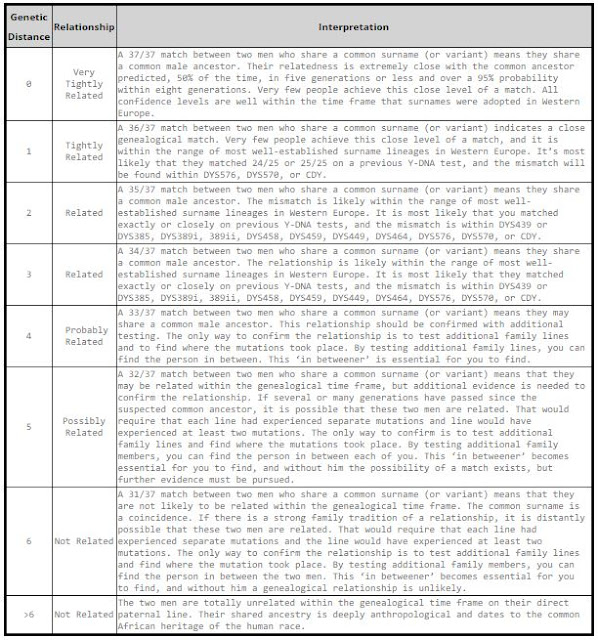Recall in the last post that I mentioned that a Hackley male had done a Y-DNA test and that he was waiting for his results. Well, his results are in and we now have a data point we can compare to the Ackley men who have also done a Y-DNA test. First, a little background on the Hackley tester.
Ancestry of the Hackley Tester
The Hackley line that we are interested in should be descendants of John Hackley, who, according to research discussed in the post on "The (Supposed) Ancestors of Nicholas Ackley", could be the brother of Nicholas Ackley. The Hackley tester believes he is a descendant of John Hackley; here is his line of descent (he is the "Living Hackley" at the bottom of this picture):
I have looked at his tree and also exchanged some e-mails with him, and he has some very good documentation for the majority of the tree. He told me that he is pretty confident in most of the relationships shown above; like most of us he is least certain about the earliest couple of generations. So, if we are willing to accept (as I am) that the Hackley tester is a descendant of the John Hackley we are interested in, we can compare his test with the three Ackley men discussed in the last post.
Comparing the Numbers
Just as we did last time, we need to compare Mr. Hackley to each of our Ackley men to determine the genetic distance between them to see if they might be related. So here it is, Mr. Hackley compared to Ackley1:
You can see that there are a lot of markers in red, meaning the values on those markers do not match each other. According to the calculation done by Family Tree DNA, there is a genetic distance of 19 between Mr. Hackley and Ackley1. Definitely not a match; recall that any genetic distance greater than 6 is considered not matching.
Mr. Hackley compared to Ackley2 doesn't look much different:
FTDNA also calculated a genetic distance of 19 for this comparison.
Mr. Hackley vs. Ackley3:
This is a genetic distance of 18. So, Mr. Hackley doesn't match any of the Ackley men who believe they are descendants of Nicholas Ackley. By extrapolation, we can conclude that John Hackley and Nicholas Ackley are probably not brothers as hypothesized in the research presented in "The (Supposed) Ancestors of Nicholas Ackley", and this certainly casts doubt on the ancestry for Nicholas proposed in that research. Of course this conclusion depends on the important assumption that the Hackley tester is a descendant of John Hackley, which we don't know for absolute certain, but the documentation seems to back up that assumption.
I guess that is good news and bad news; the good news is that we now have some data to help us draw some conclusions, the bad news is that we must conclude that John Hackley and Nicholas Ackley were probably not brothers and we are back where we started -- we don't really know anything about Nicholas Ackley's ancestors. I choose to look at this as an opportunity to continue the quest for Nicholas' ancestors. I dream of the day that we find an Ackley relative in England that has a well-documented family tree and has done a Y-DNA test (hey, I can dream, can't I?). In the meantime, we all need to keep looking.
Link of the Day
I've mentioned genetic distance several times lately in discussions about Y-DNA. The link below is from Roberta Estes' excellent blog "DNAeXplained - Genetic Genealogy", and goes into much more detail about genetic distance.
https://dna-explained.com/category/genetic-distance/
Quote of the Day
"The winners in life think constantly in terms of I can, I will, and I am. Losers, on the other hand, concentrate their waking thoughts on what they should have or would have done, or what they can't do.”
-- Denis Waitley (motivational speaker, author of "Seeds of Greatness", "The Winner's Edge")





















